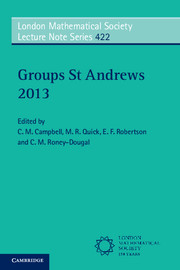Book contents
- Frontmatter
- Contents
- INTRODUCTION
- Approximate subgroups and super-strong approximation
- Width questions for finite simple groups
- Profinite properties of discrete groups
- GL(n, Z), Out(Fn) and everything in between: automorphism groups of RAAGs
- Permutation groups and transformation semigroups: results and problems
- New progress on factorized groups and subgroup permutability
- A survey on the normalizer problem for integral group rings
- A survey on Clifford-Fischer theory
- A generalisation on the solvability of finite groups with three class sizes for normal subgroups
- Automorphism groups of non-orientable Riemann surfaces
- What are the C2-groups?
- Resurrecting Wells’ exact sequence and Buckley's group action
- Recent work on Beauville surfaces, structures and groups
- Something for nothing: some consequences of the solution of the Tarski problems
- The groups of projectivities in finite planes
- On the relation gap and relation lifting problem
- Some results on products of finite subsets in groups
- Formal languages and group theory
- On the Castelnuovo-Mumford regularity of the cohomology of fusion systems and of the Hochschild cohomology of block algebras
- Recent advances on torsion subgroups of integral group rings
- On finite groups with small prime spectrum
- Solvability criteria for finite loops and groups
- The rational subset membership problem for groups: a survey
- A survey of Milnor laws
- Capable p-groups
- On the normal structure of a finite group with restrictions on the maximal subgroups
- Certain monomial characters and their normal constituents
- Recognition of finite quasi-simple groups by the degrees of their irreducible representations
- Generalized Baumslag-Solitar groups: a survey of recent progress
- Zeta functions of groups and rings – recent developments
Solvability criteria for finite loops and groups
Published online by Cambridge University Press: 05 September 2015
- Frontmatter
- Contents
- INTRODUCTION
- Approximate subgroups and super-strong approximation
- Width questions for finite simple groups
- Profinite properties of discrete groups
- GL(n, Z), Out(Fn) and everything in between: automorphism groups of RAAGs
- Permutation groups and transformation semigroups: results and problems
- New progress on factorized groups and subgroup permutability
- A survey on the normalizer problem for integral group rings
- A survey on Clifford-Fischer theory
- A generalisation on the solvability of finite groups with three class sizes for normal subgroups
- Automorphism groups of non-orientable Riemann surfaces
- What are the C2-groups?
- Resurrecting Wells’ exact sequence and Buckley's group action
- Recent work on Beauville surfaces, structures and groups
- Something for nothing: some consequences of the solution of the Tarski problems
- The groups of projectivities in finite planes
- On the relation gap and relation lifting problem
- Some results on products of finite subsets in groups
- Formal languages and group theory
- On the Castelnuovo-Mumford regularity of the cohomology of fusion systems and of the Hochschild cohomology of block algebras
- Recent advances on torsion subgroups of integral group rings
- On finite groups with small prime spectrum
- Solvability criteria for finite loops and groups
- The rational subset membership problem for groups: a survey
- A survey of Milnor laws
- Capable p-groups
- On the normal structure of a finite group with restrictions on the maximal subgroups
- Certain monomial characters and their normal constituents
- Recognition of finite quasi-simple groups by the degrees of their irreducible representations
- Generalized Baumslag-Solitar groups: a survey of recent progress
- Zeta functions of groups and rings – recent developments
Summary
Abstract
We study how the solvability of finite loops follows from certain properties of their multiplication groups and inner mapping groups. In this survey we review the progress of this research problem from the last two decades and the best results achieved so far. We also introduce a few new improvements with proofs in order to give the readers some idea about the basic methods used in this study.
Introduction
Let Q be a groupoid with a neutral element e. If the equations ax = b and ya = b have unique solutions x and y in Q for every a, b ∈ Q, then we say that Q is a loop. If a loop Q is associative, then it is in fact a group. For each a ∈ Q we have two permutations La (left translation) and Ra (right translation) on Q, defined by La(x) = ax and Ra(x) = xa for every x ∈ Q. These permutations generate a permutation group M(Q), which is called the multiplication group of Q. Clearly, M(Q) is a transitive permutation group on Q. The stabilizer of the neutral element e is called the inner mapping group of Q and denoted by I(Q). If Q is a group, then I(Q) is just the group of inner automorphisms of Q. The concepts of the multiplication group and the inner mapping group of a loop were defined by Bruck [1] in 1946.
A subloop H of Q is normal in Q if x(yH) = (xy)H, (xH)y = x(Hy) and xH = Hx for every x, y ∈ Q. As in groups, a subloop H of a loop Q is normal if and only if H is the kernel of some homomorphism of Q. A loop Q is said to be solvable if it has a series 1 = Q0 ⊆ · · · ⊆ Qn = Q, where Qi−1 is normal in Qi and Qi/Qi−1 is an abelian group for each i.
Connected transversals
Let G be a group, H ≤ G and let A and B be two left transversals to H in G. We say that the two transversals A and B are H-connected if a−1 b−1 ab ∈ H for every a ∈ A and b ∈ B.
- Type
- Chapter
- Information
- Groups St Andrews 2013 , pp. 360 - 367Publisher: Cambridge University PressPrint publication year: 2015



